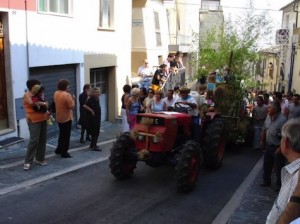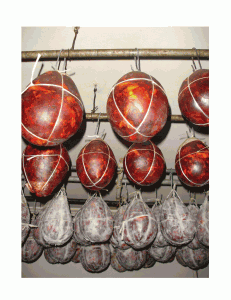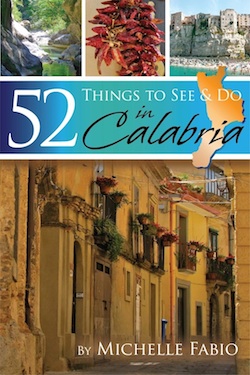Author Archive
Calabrese Folk Music from Tarantella Power 2010: Aquila Bella
As many of you know, my village was home to Tarantella Power again this year; I do have a video of tarantella music and dancing to share as well as more photos from the five-day (!) event, but first I want to share with you this video of one of my absolute favorite Calabrese folk songs, Aquila Bella:
The song is about a beautiful eagle that delivers a love letter to the singer’s beloved — unless she’s sleeping, in which case, the eagle is to let her sleep (and dream sweet dreams) because for her the night turns:
“Dorma gioiuzza, fai li sogni d’oru; Ca c’esta cu pe tia la notta gira.”
*le sigh*
Happy Love Thursday everyone!
Gita Italiana 2010: The Texan Connection
 Can you believe we’ve already reached the end of the Gita Italiana 2010? Without further ado, here’s our final installment from Tui of Mental Mosaic. Enjoy!
Can you believe we’ve already reached the end of the Gita Italiana 2010? Without further ado, here’s our final installment from Tui of Mental Mosaic. Enjoy!
*
As a recent transplant to the Dallas – Fort Worth Metroplex (via Naples, Italy and the Pacific Northwest) I must agree with the state slogan of, “Texas, it’s like a whole other country.” It’s not only because the state is huge, or the fact that it has its own power grid. There is just something about Texas that sets it apart from other states. Every time I land in Dallas, for instance, I feel like I should get my passport stamped.
So how does all this fit in with the Gita Italiana? Well, I’ve discovered that the bel paese and the Lone Star State have a surprising amount of things in common. Don’t believe me? Read on!
Iconic Shapes
If you pulled a tortilla chip out of a bag and it were shaped like either Texas or Italy, you might notice. You might even get a few bids if you placed that chip on eBay. At the very least, your friends would probably nod in agreement as you dipped it in salsa and took a bite. Try the same with a chip resembling Colorado or Belgium, however, and people will think you’re nuts. Those shapes are not nearly as striking or recognizable.
Texas and Italy, on the other hand, are like the geographical equivalents of Beyonce or Christine Hendricks; they are not afraid to flaunt their shape. While living in Naples, I even had people use my lower leg as a makeshift map from time to time. I confess that I am so bad at geography that this was the only way to get their point across, but hey, it worked. And while I still think there is a market for tights imprinted with a map of Italy, there is definitely a market for anything Texas-shaped. You name it, if there’s a way to produce a Texas-shaped version of a product, someone will do it, and Texans will buy it. I’ve seen Texas-shaped belt buckles, tattoos, muffins, swimming pools, crewcuts – there’s even a Flickr pool of Texas-shaped things.
Love of Wine
We all know that Italy produces some of the finest wines in the world, however Texas makes its share of vino, too. The state has over 200 family-owned vineyards, and a whole bunch of wineries. The city of Grapevine is named after the indigenous mustang grape (Vitis Mustangensis) and hosts the largest wine festival in the southwest. Meanwhile, DFW International Airport has an on-site winery, which offers the aptly named “Aero Port.”
I honestly can’t say yet how Texan wines compare to Italian ones (ask me again after Texas Wine Month this October) but I can tell you that the European wine industry will be forever grateful to a Texan named Thomas Munson. Munson developed a vine hearty enough to resist phylloxera, an aphid-like critter which wreaked havoc on grape harvests in the 19th century, so propose a toast to him the next time you open a tasty bottle of Italian red.
Unique Dialects
While living in Naples, I enjoyed learning phrases in Neapolitan dialect, as well as songs in dialect such as “O Sole Mio,” and “Funiculi, Funicula.” I was surprised, however, to learn that Texas has its own dialect. I am not just talking about the contagious Texan twang. Texas actually has its own unique version of German, thanks to generations of immigrants. The German word for “skunk” is stinktier, for example, while the Tex-German variation is stinkkatze.
Wacky Men in Charge
It would take a lot to rival the buffoonery of Italy’s prime minister, Silvio Berlusconi, but from what I’ve seen here in Texas, Governor Rick Perry has his moments. Not only has Perry been dubbed “Governor Good Hair” due to his immaculate coiffure, but he’s been known to impulsively smooth the unruly locks of strangers in the audience during public appearances. Also, back in April of this year, Perry shot and killed a coyote … while out jogging! He claims the coyote was menacing his pooch, but I have my doubts. I’ve lived near coyotes before, and they are very skittish. In any case, who packs heat on their morning jog?
Freakishly Large Insects
If you’ve ever spent time in the Italian countryside, chances are you’ve seen those huge, black bumblees known as Calabrone. While your average bee buzzes like a Vespa (pun intended!) a Calabrone rumbles like a Harley Davidson, and just like a “hog”, you can hear them coming a mile away. Fortunately, Calabrone rarely sting humans.
Turns out that Texas has its share of big bees, too. Lately I’ve spied Cicada Killer Wasps in our yard. As the name suggests, this creature kills cicadas (which, I might add, is another hefty-sized bug.) Cicada Killers are an impressive 2″ long and thankfully, like the Calabrone, they have better things to do than sting you. I still tend to shriek and run the other way, though, whenever I see one.
Regional Pride
More than anything else, both Texas and Italy share a deeply rooted sense of pride, and locals are eager to share their traditions with you. Nor is Texas afraid to take on what it finds cool about Italy and put a Lone Star spin on it. There are plenty of Texan towns named after Italian cities: Italy, Florence and Naples, to name a few. Dallas has a mozzarella company, as well as one of the few Vera Pizza Napoletana (VPN) certified restaurants in the USA, while the Kimbell Museum in Fort Worth is home to the only Michelangelo painting in the Americas. I still get a kick out the Maccaroni Grill, an Italian restaurant where the ladies room is labelled, “Uomini.” (Pretty confusing, since that means “men” in Italian.)
The Texan love of Italy runs deep, but doesn’t veer into wannabe behavior. One incident in particular summed this up for me, it was when the waiter at an Italian place in Dallas exclaimed, “Mangia, y’all!” after setting our entree on the table. At that moment I realized that no matter how passionate this guy was about Italian cuisine, he was still Texan through and through.
So there you have it, a brief sojourn off the boot and over to the land of cowboy boots, where there is more in common than you might expect!
P.S. I want to thank Michelle for inviting me on her Gita Italiana. She was the first expat I connected with online while living in Italy. From Bleeding Espresso, I quickly found Cherrye Moore, another expat who just so happens to hail from the great state of Texas. Although we’ve never met in person, those two are a continuing source of inspiration to me. 🙂
*
Tui Cameron is a writer and musician who recently settled in the Dallas/Fort Worth Metroplex after having lived in Italy, Belgium and the Pacific Northwest. She disagrees with the saying, “It’s a small world.” In her experience, it’s actually a great big world with an endless array of places to explore. You can find her on Twitter @mentalmosaic, and at her blog, Mental Mosaic: Even home is a travel destination.
*
Wonderful and so sweet too, Tui; grazie mille!
Thanks so much to everyone who wrote, read, and commented on the series; I’ve had so much fun reading about all different parts of Italy from some of my favorite bloggers, and I hope you enjoyed it as much as I have.
Looking ahead to September, remember it’s Ovarian Cancer Awareness Month, so there will be lots of fun happenings here (including giveaways!) in order to spread the word about this disease that affects far too many women. See you next month!
100 Places in Italy Every Woman Should Go by Susan Van Allen
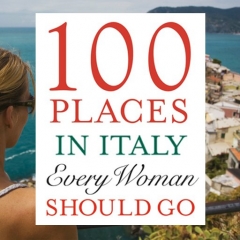 Remember when Susan Van Allen was here a while back telling us why women love Italy so much? Well today it’s my turn to tell you a little more about her book, 100 Places in Italy Every Woman Should Go.
Remember when Susan Van Allen was here a while back telling us why women love Italy so much? Well today it’s my turn to tell you a little more about her book, 100 Places in Italy Every Woman Should Go.
Susan has just released an UPDATED version of the 2009 edition; additions include a map, budget tips, and online resources, where Bleeding Espresso is included. Woohoo! Grazie, Susan!
100 Places in Italy Every Woman Should Go would be a true treasure in your library, virtual library, or even in your life via iPhone app.
Whether you want to find a cooking course, spa, religious retreat, great beach, or just some fabulous shopping, Susan has it covered –in every corner of the Bel Paese. When I first received this book, I thought it would be something I’d flip through every now and again when the mood struck; instead I found myself reading chapters straight through, imagining myself visiting all of the wonderful places Susan describes so well.
The tone is friendly and the advice sincere, so you really do feel like you have a knowledgeable girlfriend by your side with the inside scoop on where you should go on your next Italian vacation. I probably don’t need to tell you this book would make a *fabulous* gift for your favorite Italophile who also happens to be a lady, either.
*
What’s a place in Italy you feel is appealing to females?
*
For more from Susan on 100 Places, be sure to check out her interview on the Eye on Italy podcast, which I co-host.
Subscribe to my Book Reviews feed — book reviews ONLY, which aren’t published to the main feed — by visiting Feedburner.
Gita Italiana 2010: The Rhythm of the Seasons in Abruzzo
 Today we have a special treat for the Gita Italiana: this morning we’re spending time with Mary of The Flavors of Abruzzo, and then this afternoon, I’ll be posting information about the final book giveaway of August so be sure to check back later as well. But now, welcome Mary!
Today we have a special treat for the Gita Italiana: this morning we’re spending time with Mary of The Flavors of Abruzzo, and then this afternoon, I’ll be posting information about the final book giveaway of August so be sure to check back later as well. But now, welcome Mary!
*
When Michelle proposed the Gita Italiana, I thought about all of the wonderful things I could say about Abruzzo. I could talk about the National Park, the wildlife, the breathtaking views of the Maiella that I can see from my town. Or, I could talk about how close we are to the sea and the wonderful historic treasures that are all around us. But, as fantastic as all of those things are, they are not what really comes to mind when I think about my life here in the heart of Italy.
Upon moving to Abruzzo it felt as though I almost went back in time because this place is so closely linked to the rhythms of the earth. That link is so strong that even a person who has newly arrived can feel it. Yes, I know all about harvest time and I’ve grown my own vegetables, but I’ve never felt as attuned to the seasons as I do here. Even though we live in a modern world with computers and cell phones, we still take part in those seasonal activities that have been going on here for generations and generations, back into the mists of time.
Forget about football games and hayrides. These seasonal activities are all related to putting food on the table.
Spring is the time to plant and you’d better plant when the moon is in the right phase or your seeds won’t grow the way they should. Then the grain is harvested and the fields prepared for the next crop.
Of course, summer is when we enjoy the abundance of fruits and vegetables from the garden but then, in late summer, it’s time to preserve part of what the garden has yielded and can some tomatoes. You can make sauce or can them in chunks or even whole, but everyone does it. It becomes a part of conversation. No longer is the opening phrase about the weather, now it centers on whether or not you’ve done your tomatoes yet and how you do them.
When early fall rolls around it’s time for the vendemmia. Then later comes olive harvest time when everyone gathers their olives and takes them off to the frantoio for making oil. And once the cold temperatures arrive it’s time to butcher the pigs and make sausage.
Yes, there are some people who don’t do these things, but the majority of people are involved in at least some of them. We don’t have grapes, for example, nor do we raise pigs, so there is no butchering for us (thank goodness), but our lives still revolve around these activities as we watch the tractors full of grapes go by (or peaches when the season is right).
And, while you can sometimes get some vegetables and fruits out of season here, you pay very dearly for them. Unlike supermarkets in the states that seem to have grapes and cherries all year round, you can really only get them in season here. Consequently, I had no idea that there were winter vegetables, like broccoli for example.
While life is not perfectly idyllic here, there is definitely a fair amount of tranquility that comes from being so closely bound to the seasons. Since moving here, my life has definitely changed, for the better.
*
Some people said Mary was crazy when she walked away from a promising IT career to move to her ancestral town in Italy. Now 4+ years later she works part-time as a Freelance Translator and Writer and the rest of the time she spends chasing after her 2 year old son and enjoying life in Abruzzo. You can catch up with her on her blog: The Flavors of Abruzzo.
*
Grazie mille Mary!
Gita Italiana 2010: Salento — Not Your Typical Italy
 Today’s Gita Italiana stop takes us to the Salento courtesy of Tina Ferrari, who you can find at TinaFerrariTango.com. Welcome Tina!
Today’s Gita Italiana stop takes us to the Salento courtesy of Tina Ferrari, who you can find at TinaFerrariTango.com. Welcome Tina!
*
Sometimes I get so caught up in daily life that I have to stop, look around, pinch myself and realize where I’m living. The Salento is the sub peninsula that makes the “heel” if you are looking at a map of Italy.
It’s different than the rest of Italy. Every region has its own identity and traditions, but here in the south, the difference is pronounced. On one hand, it’s the Italy people dream of, untouched by mass tourism. Things are slow, shops close from 1:00 to 5 or 5:30 in the afternoon, people hit the streets of Lecce in bici, on their bicycles, green grocers can be found everywhere, and the gelato is just right. All the things you might fantasize about when thinking of Italy, you will probably find here.
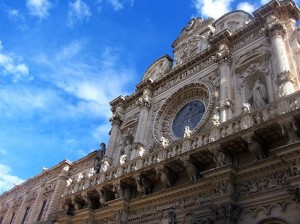
© Tina Ferrari
On the other hand, I feel like I’m in my own special place, removed from the rest of Italy. I think anyone in southern Italy, be it Calabria, Basilicata or Sicily, might feel the same way. Being at the bottom of the peninsula, the Salento is nice and isolated. It’s not the easiest to reach, and when you do finally get here, you feel like you are separated, in a way, from Italy. On the train along the Adriatic Coast, as soon as you pass Bari, your view out the window suddenly consists of red soil (with olive trees) muretti a secco (dry stone walls characteristic of this region), and the occasional trullo.
The Salento even has its own railway system: the Ferrovie del Sud Est! It’s truly a parallel universe. At the regular TrenItalia train station in Lecce, you’ll find chaos and grumpy employees, as you would at any station belonging to the national train network. But pop into a Ferrovie del Sud Est station in one of the neighboring Salento towns, and it’s a completely different set up. Complete tranquility. “Is the train for Lecce running?” you ask. The man at the biglietteria, calm as can be with glistening eyes, shrugs his shoulders, nods his head and says, “Sure.” You press further: “What time?” He nods his head again and answers, “Quando vuoi. When you want.” You move to the platform to wait for the train. The same man comes out and manually lowers a bar to block automobile traffic from crossing the tracks, and finally, a tiny toy train pulls up. Off you go.
On the other hand, it is also a region of progressive artists. Plenty of modern talent comes from the Salento, including musicians such as Dolcenera, i Bambini Latini and Sud Sound System. In Lecce, artisans sell their wares on the streets on summer evenings, and galleries abound with original, avant-garde creations by local artists.

© Tina Ferrari
It’s strange to think that I am five hours from Rome on the train, but if I were to take my friend’s boat, I would get to Corfu (Greece) in only three. (In fact, there are a few towns near me where you’ll hear people speak Griko, a “modern” Greek spoken in the Magna Graecia region of Southern Italy, including the Salento.) It’s also strange to think that after all the time an American English speaker might spend learning to roll their r’s properly in order to pronounce Italian, if you want to speak Leccese, the American “r” is actually much better, at least when it follows a “t.”
Perhaps the language here is Italian, perhaps this region belongs to the republic of Italy, but once in a while I realize, as I walk through Lecce’s historic center in the morning, looking up at homes made of white-gold Leccese stone and the contrast against the Mediterranean blue sky, or as I make my way down the road on the way to Gallipoli, surrounded by oleanders and prickly pears, with the salty scent of the Ionian Sea in the air, that I am in a very special, truly unique Paradise in the south: the Salento.

© Tina Ferrari
*
Tina Ferrari is an Italian-American tango dancer, translator and writer living in Lecce. You can find her at TinaFerrariTango.com.
*
Grazie mille Tina!
Tomorrow: a quick trip to Abruzzo.









